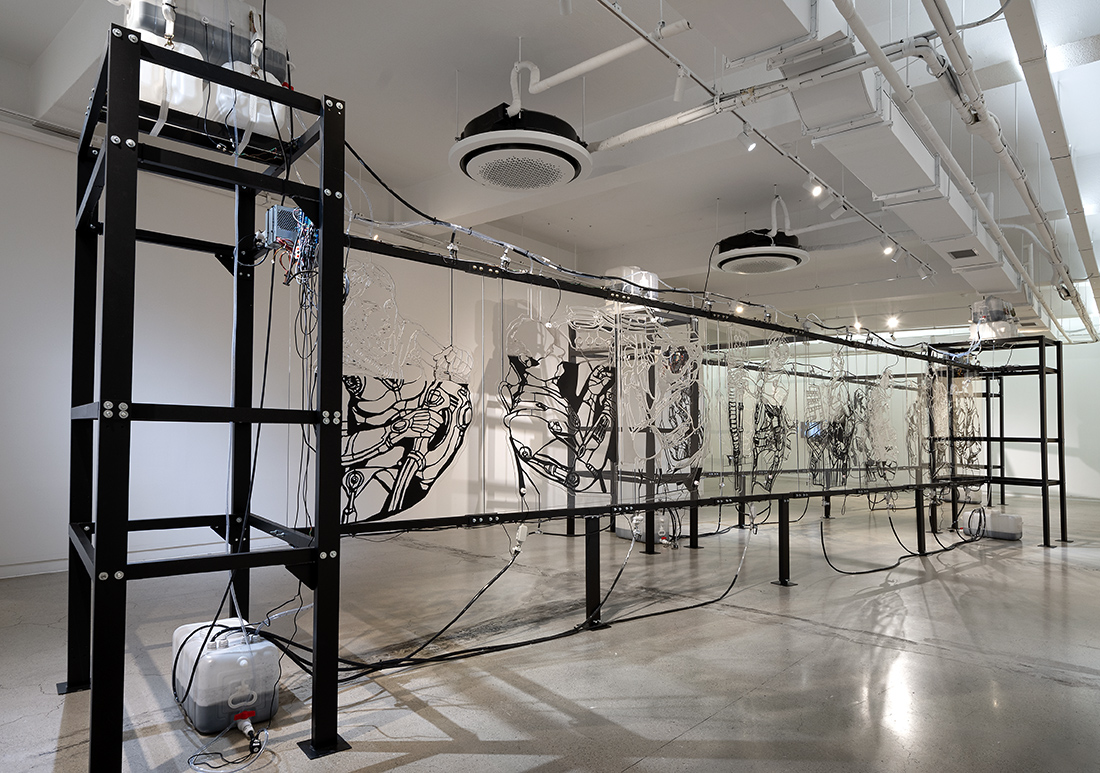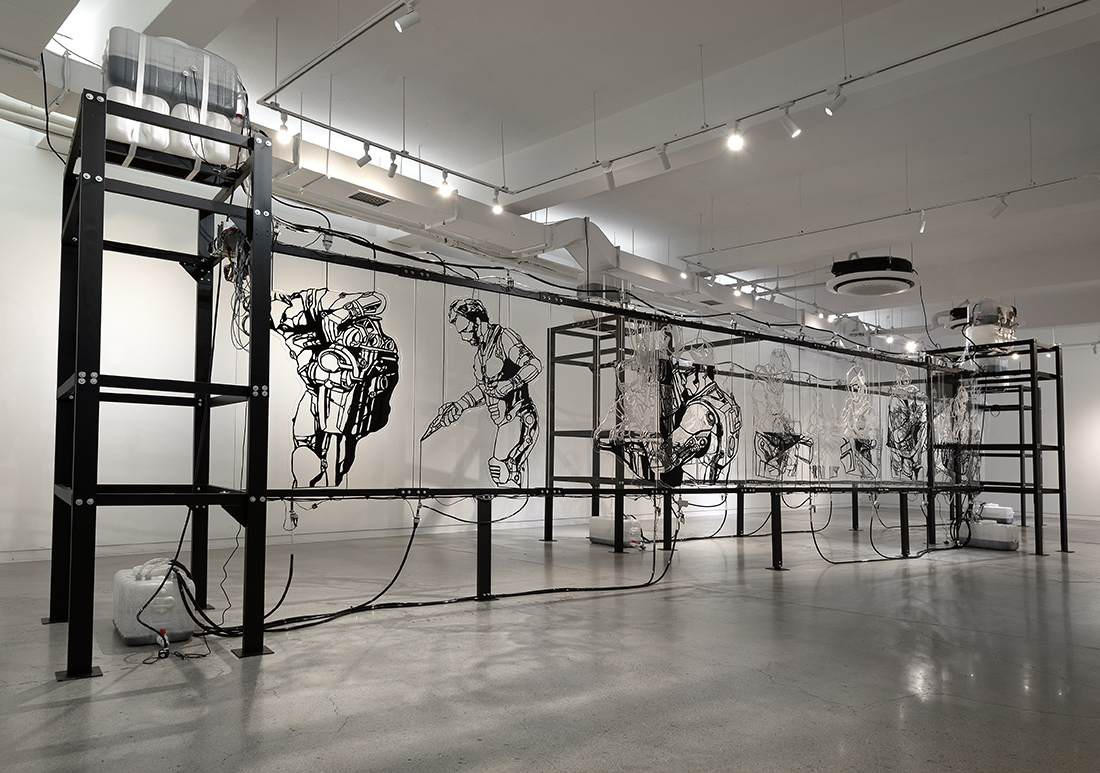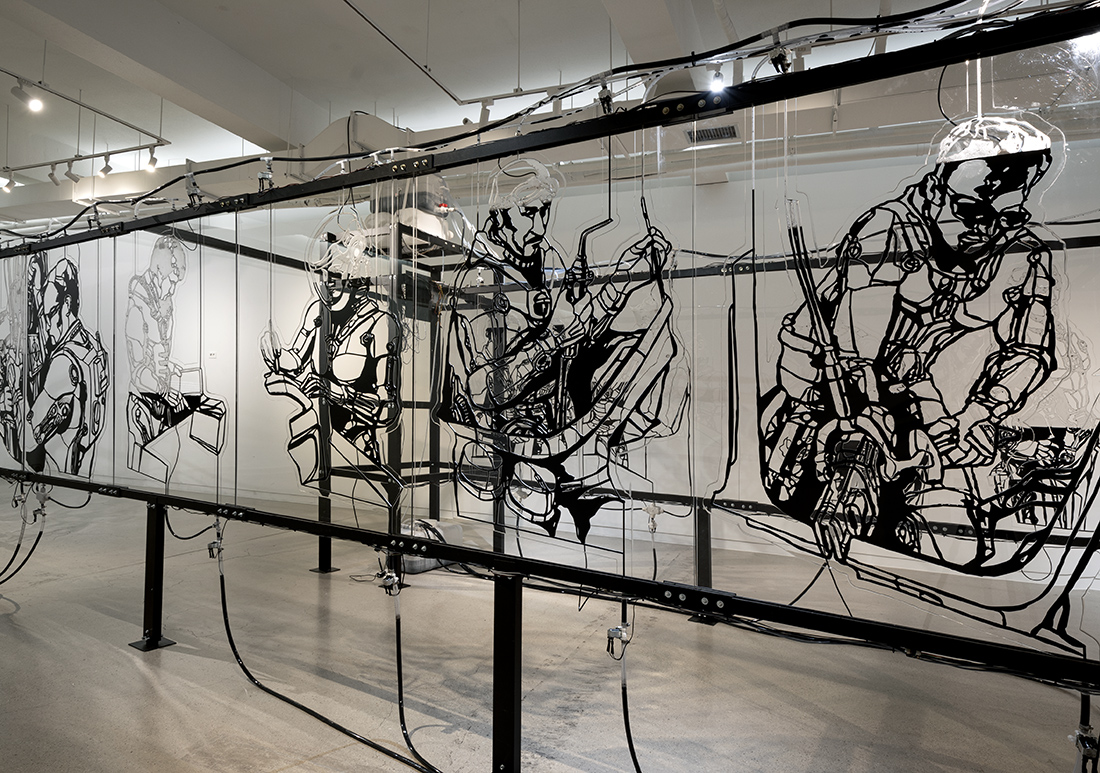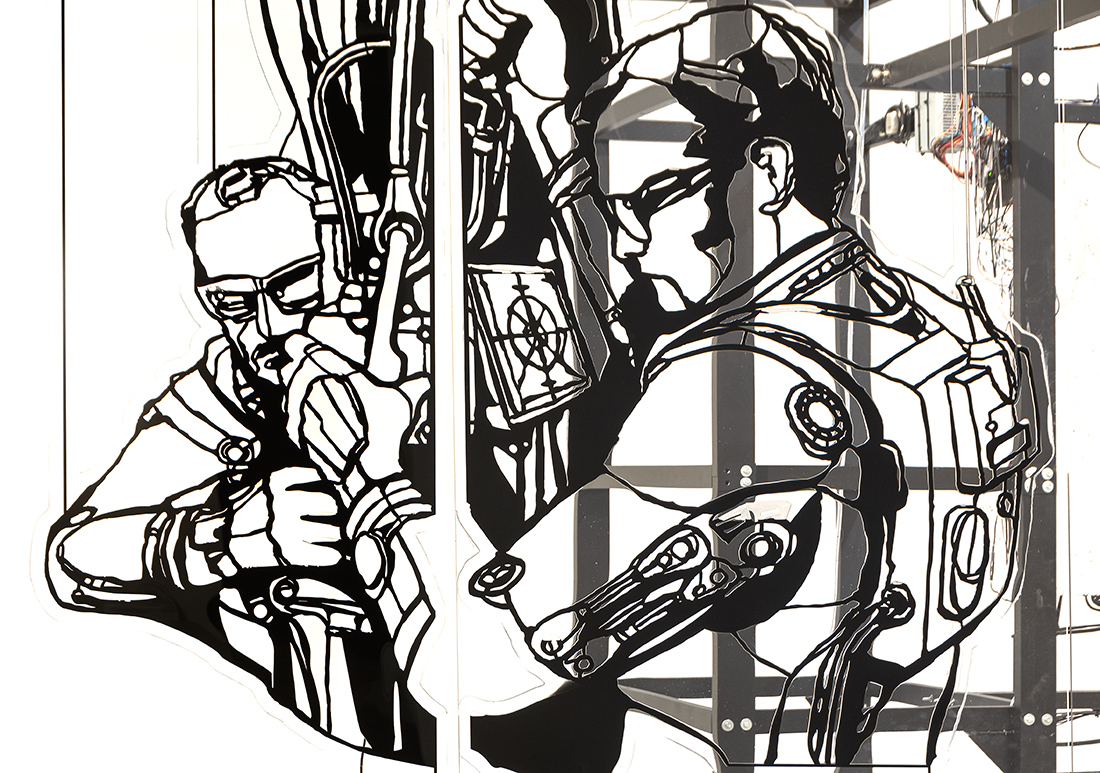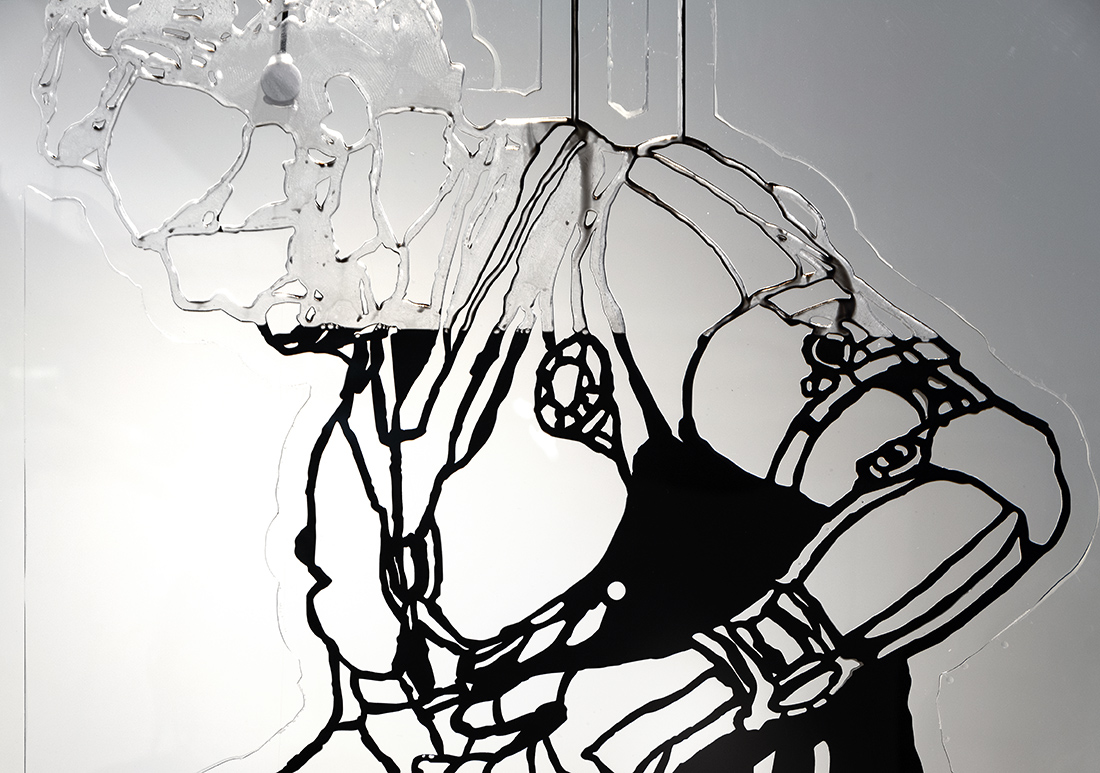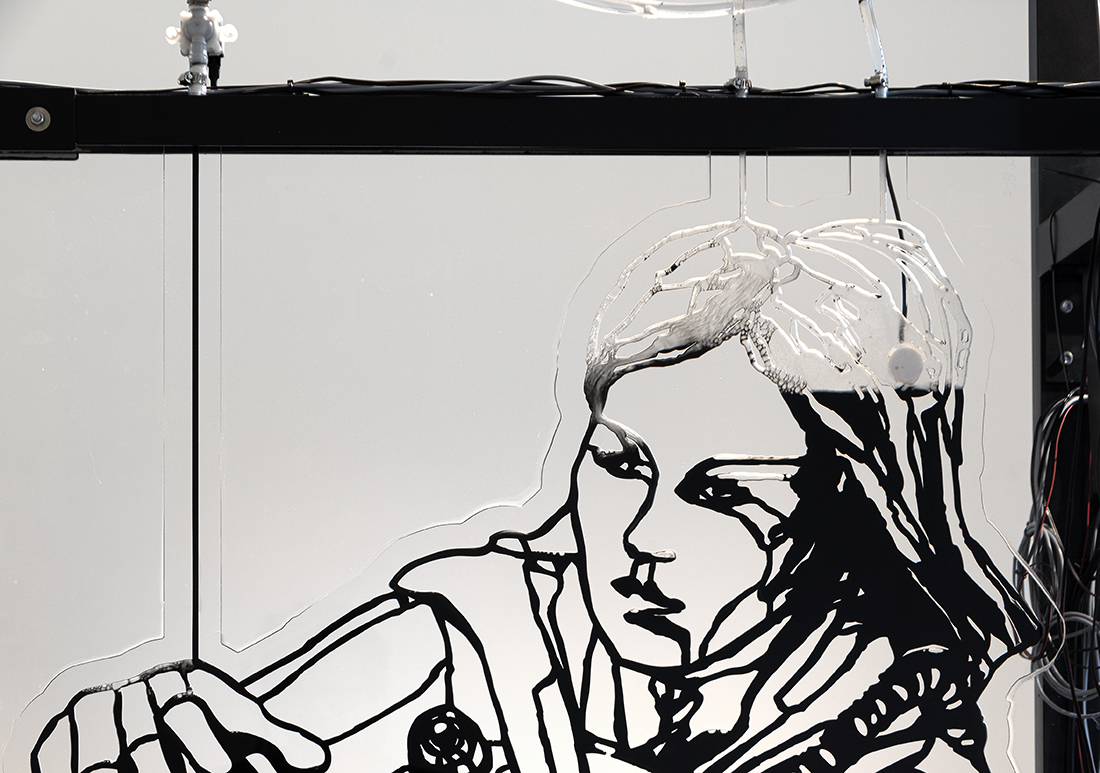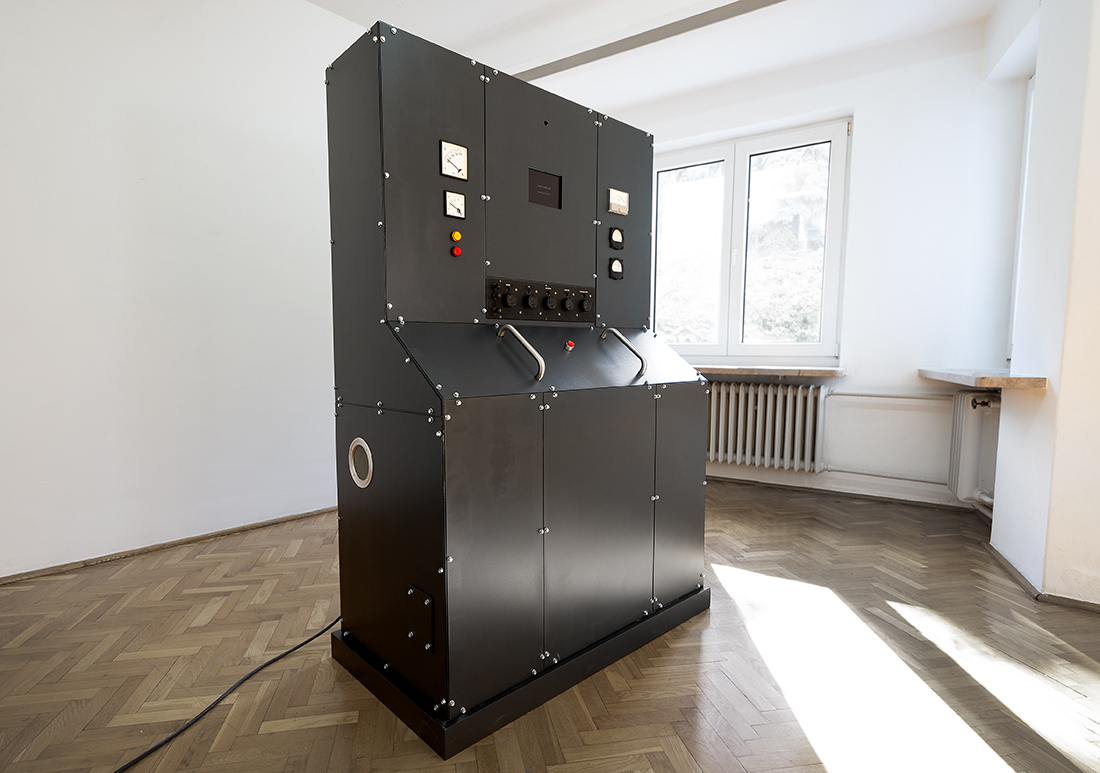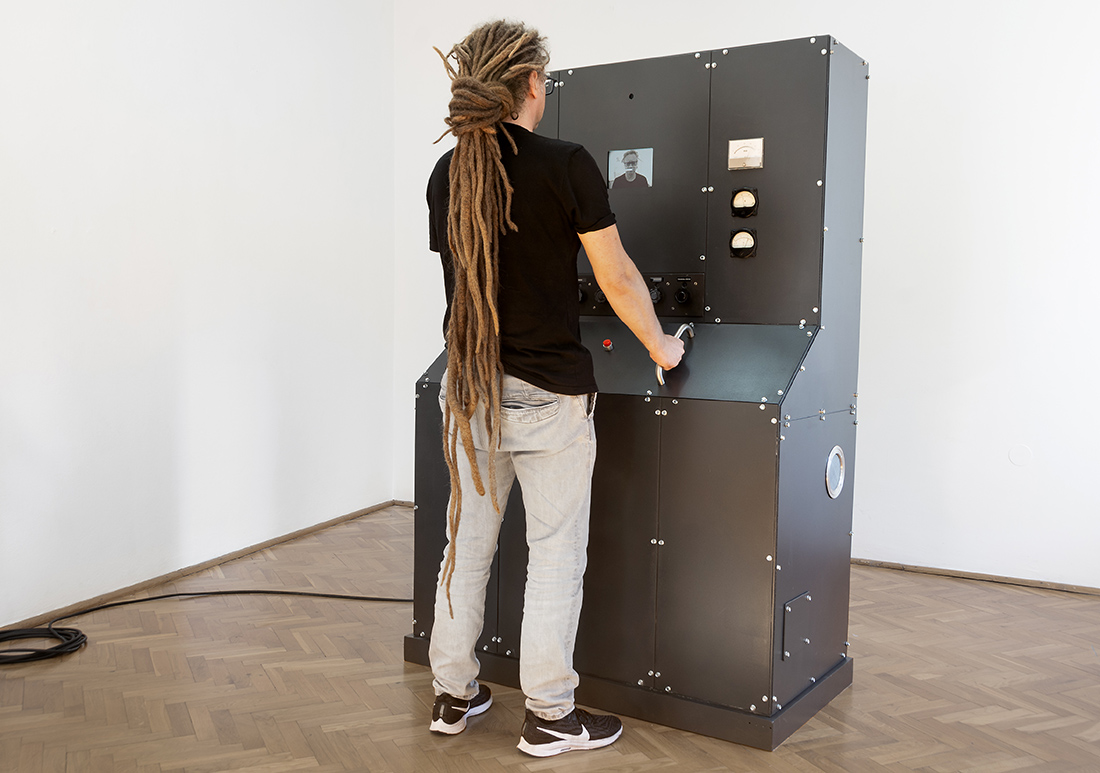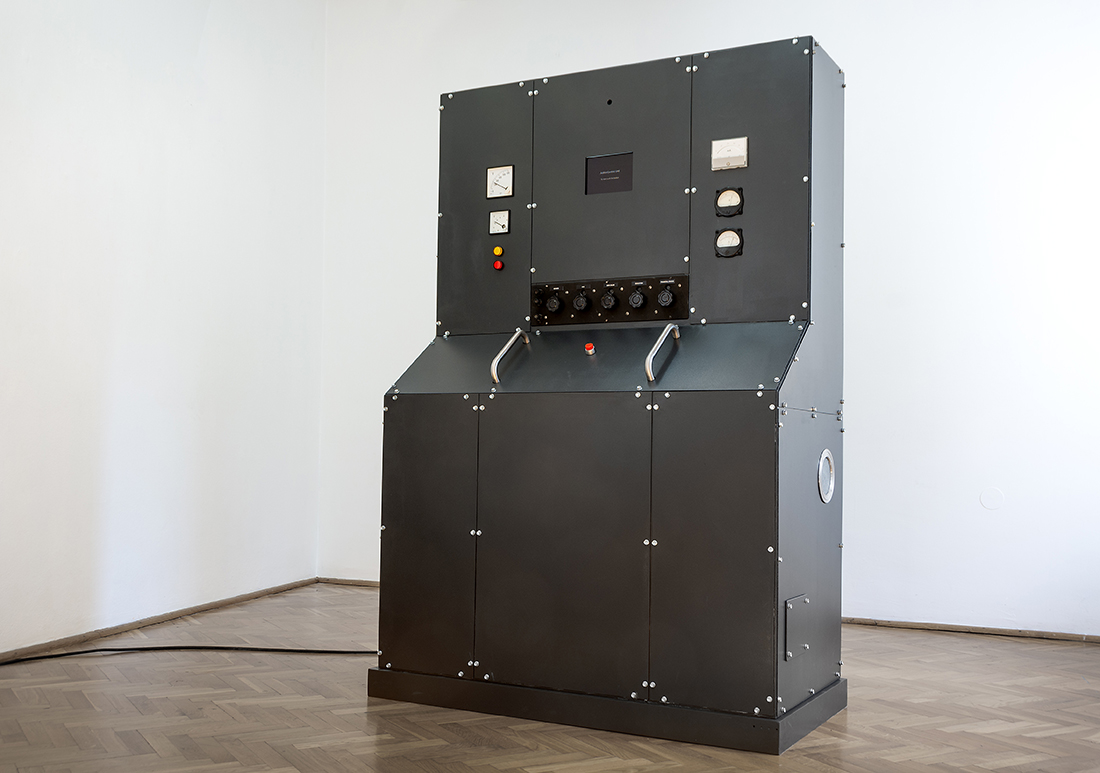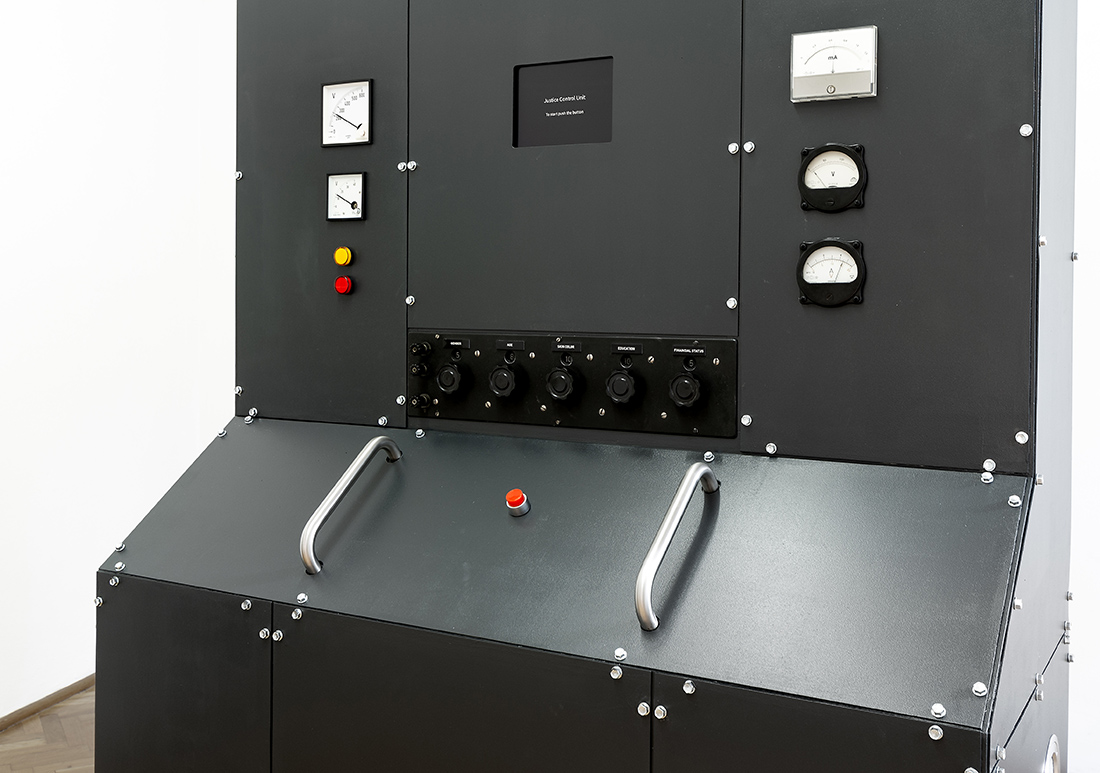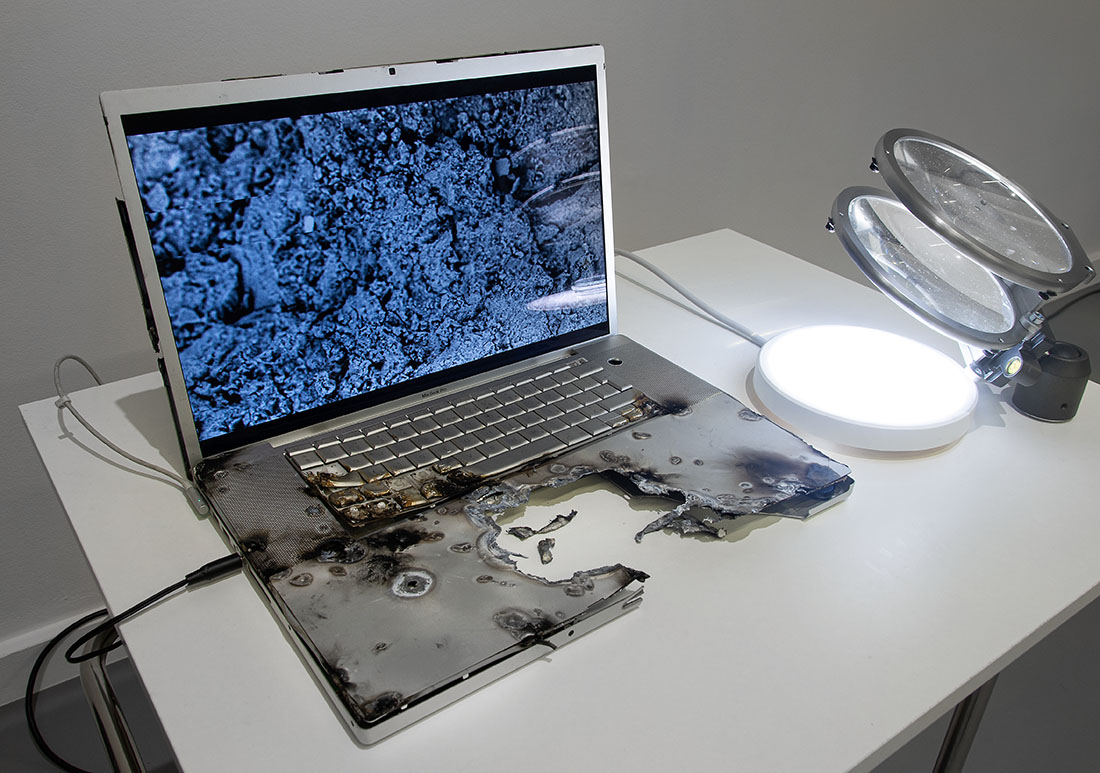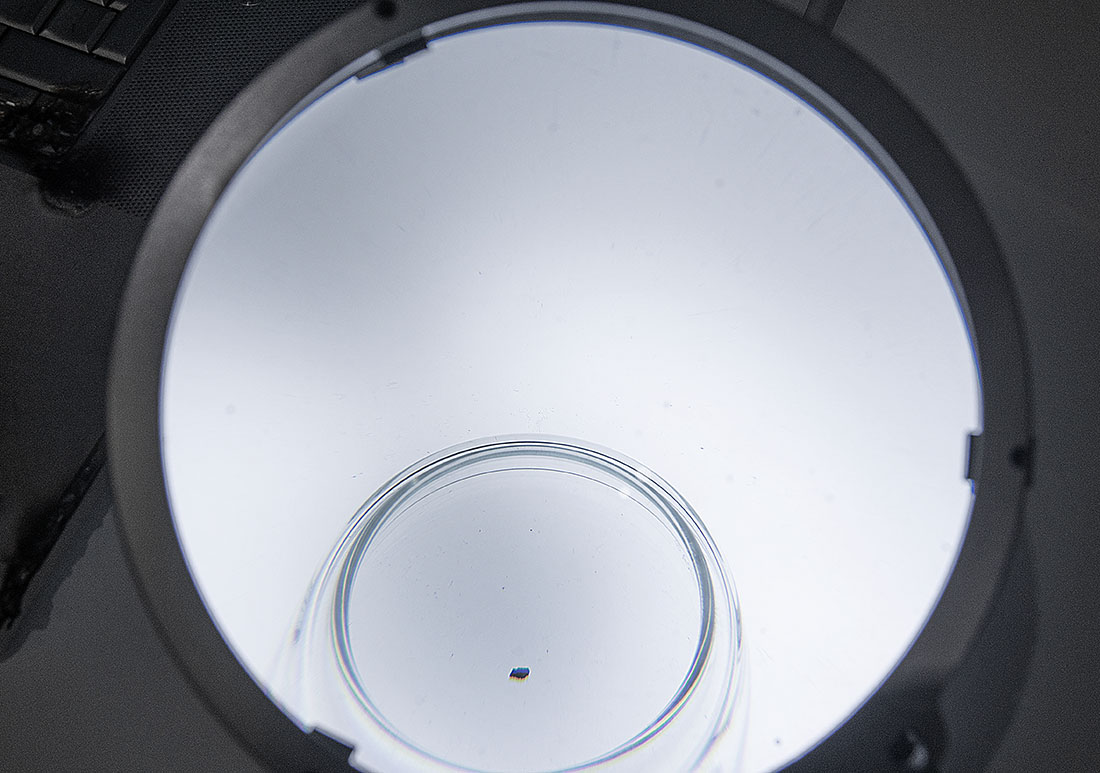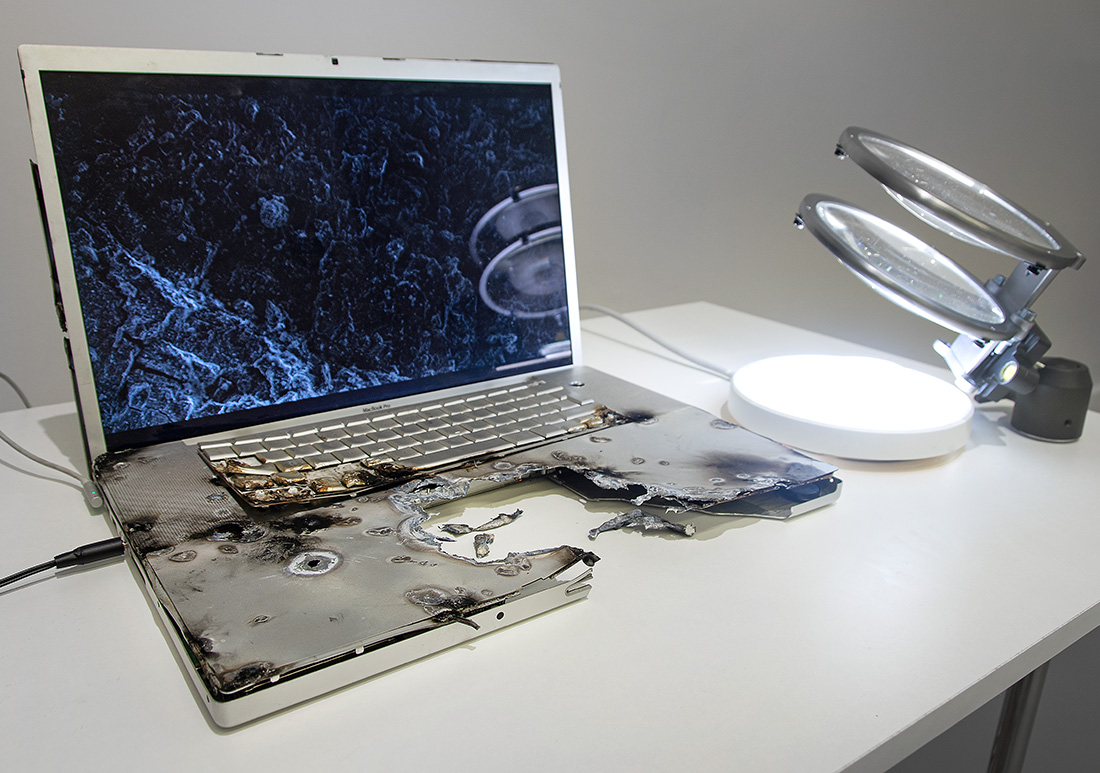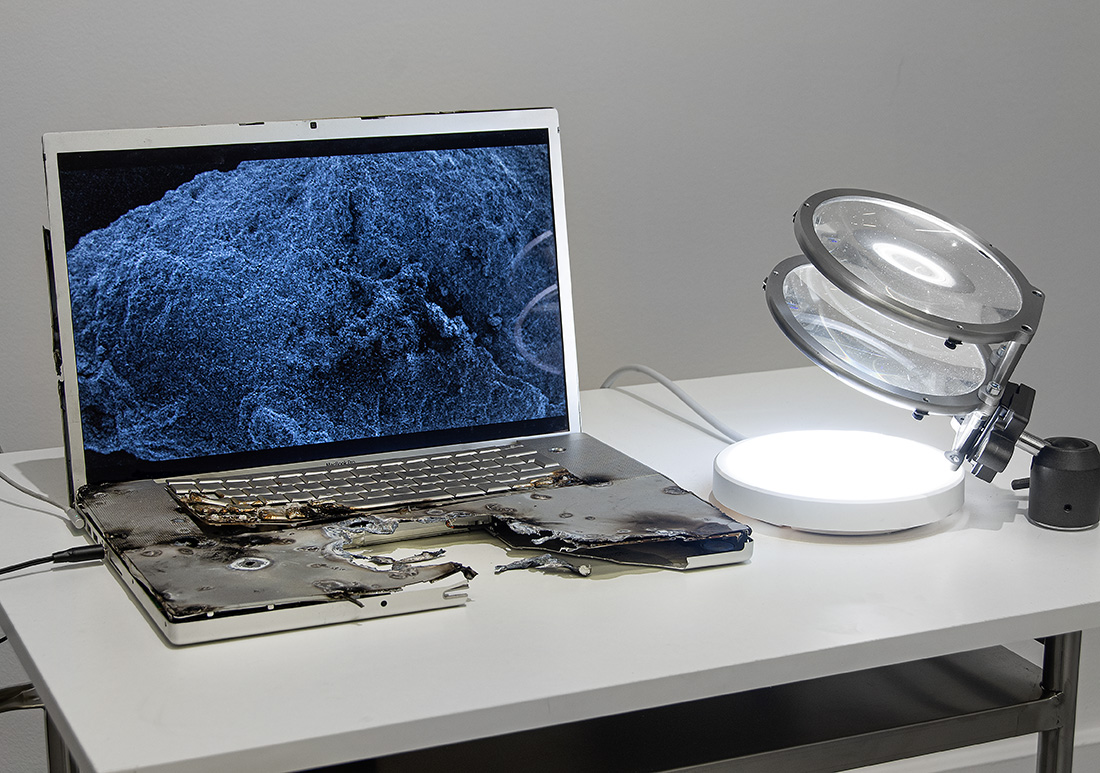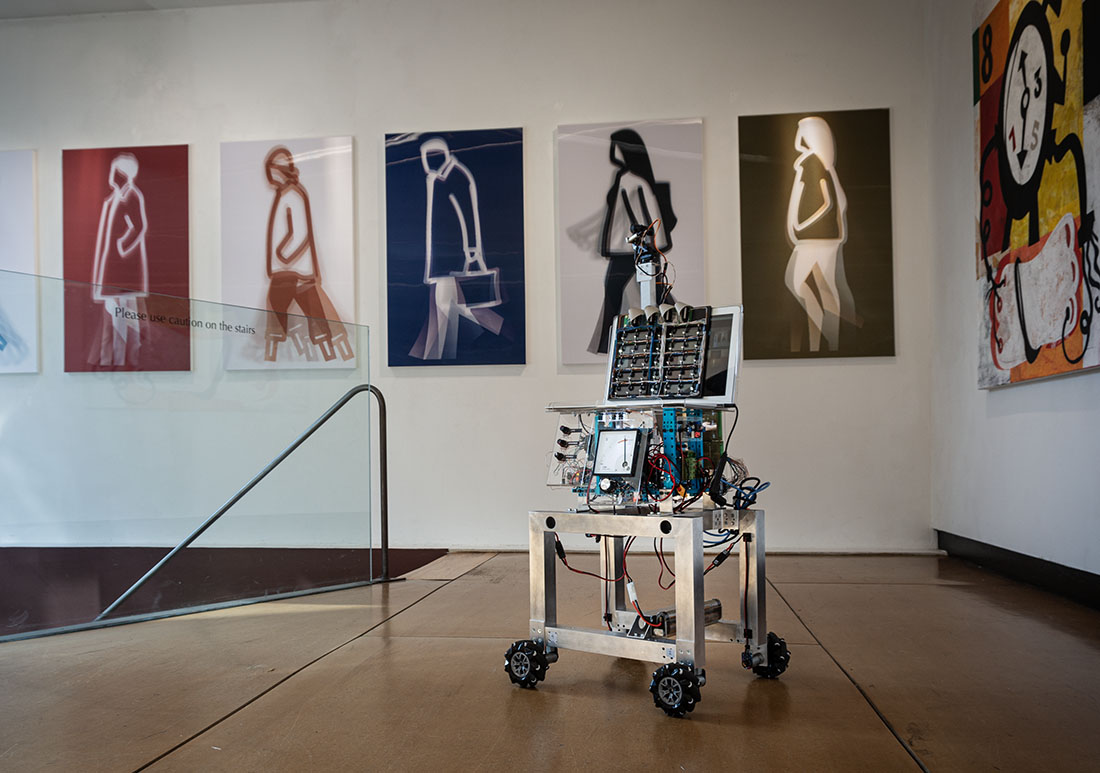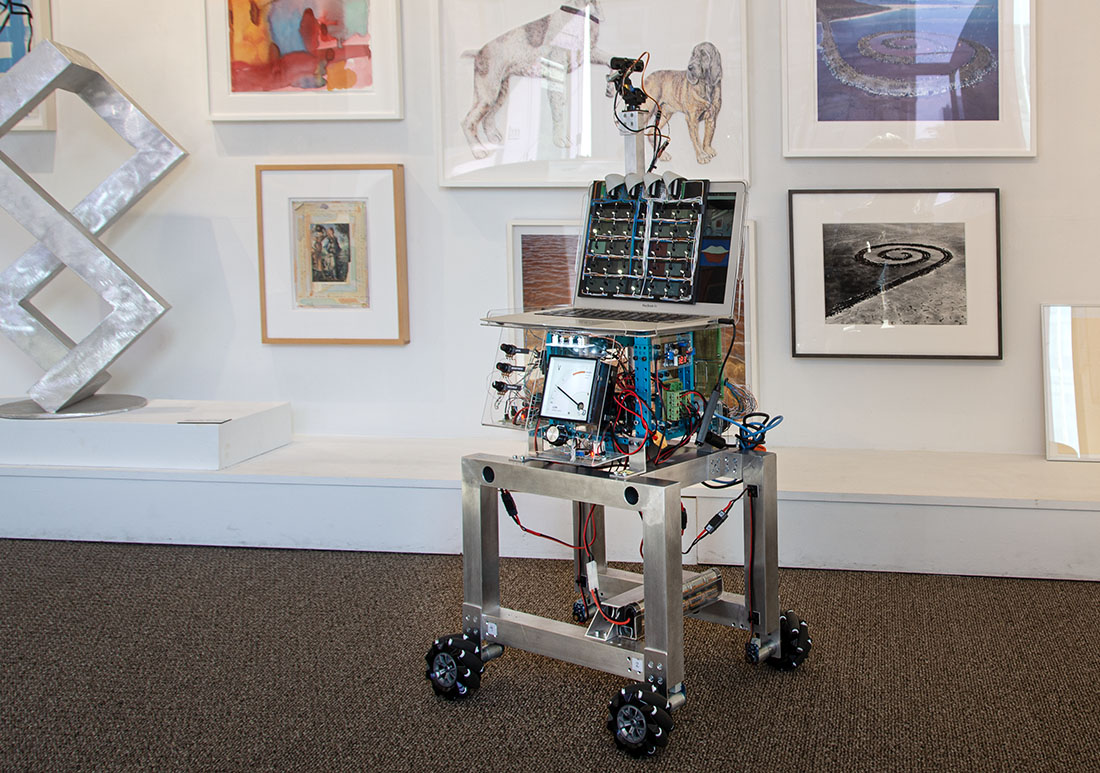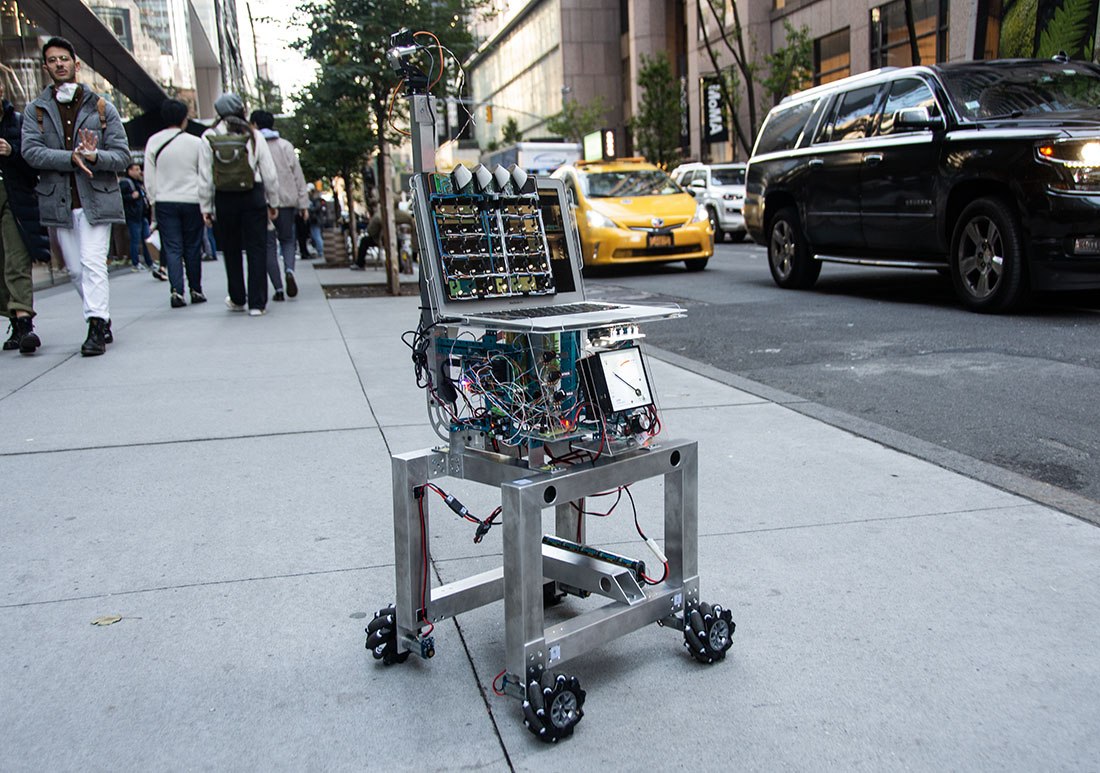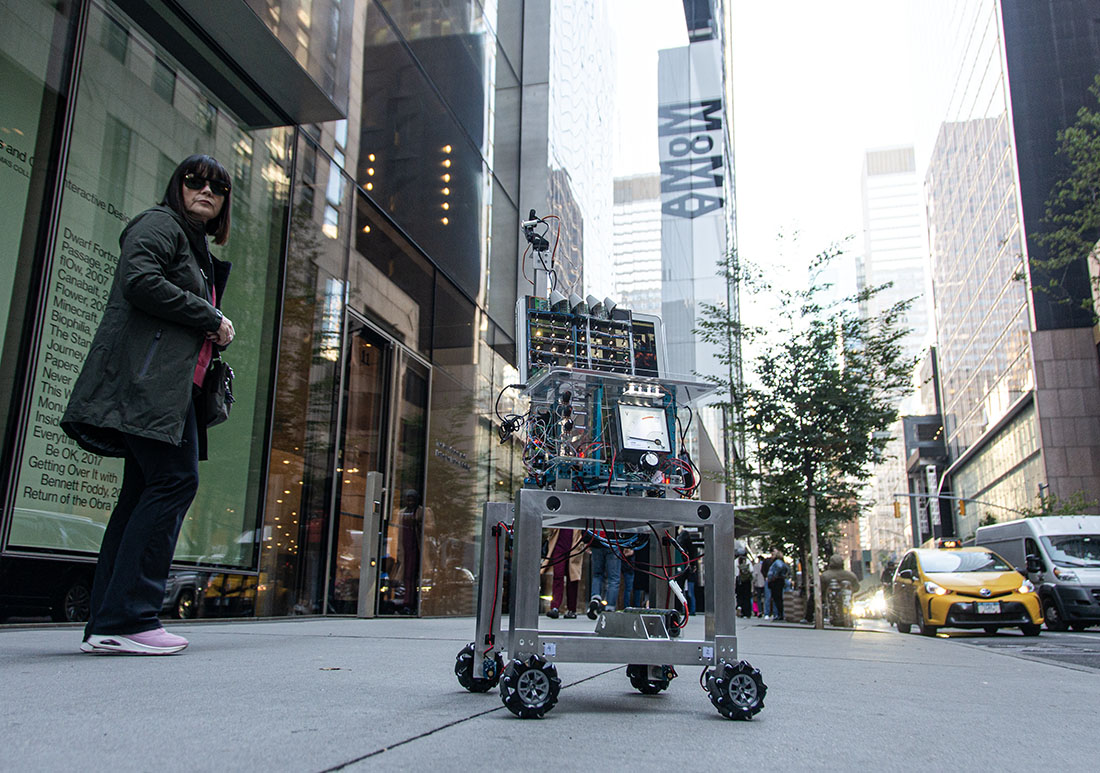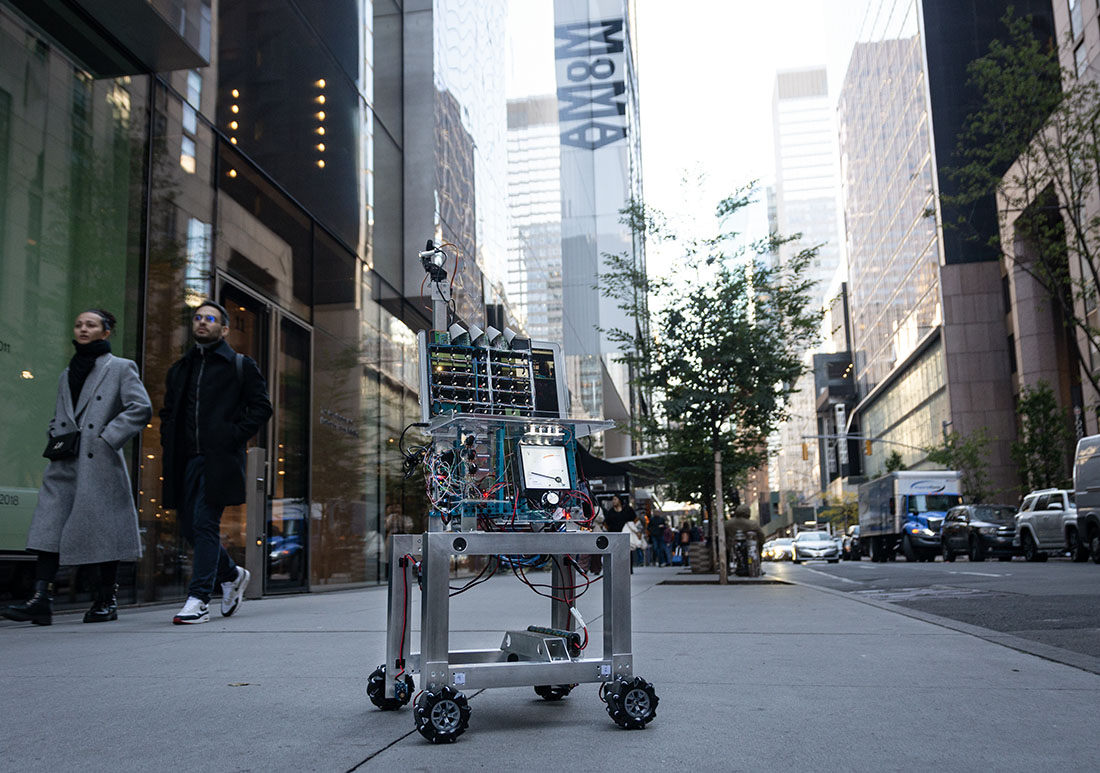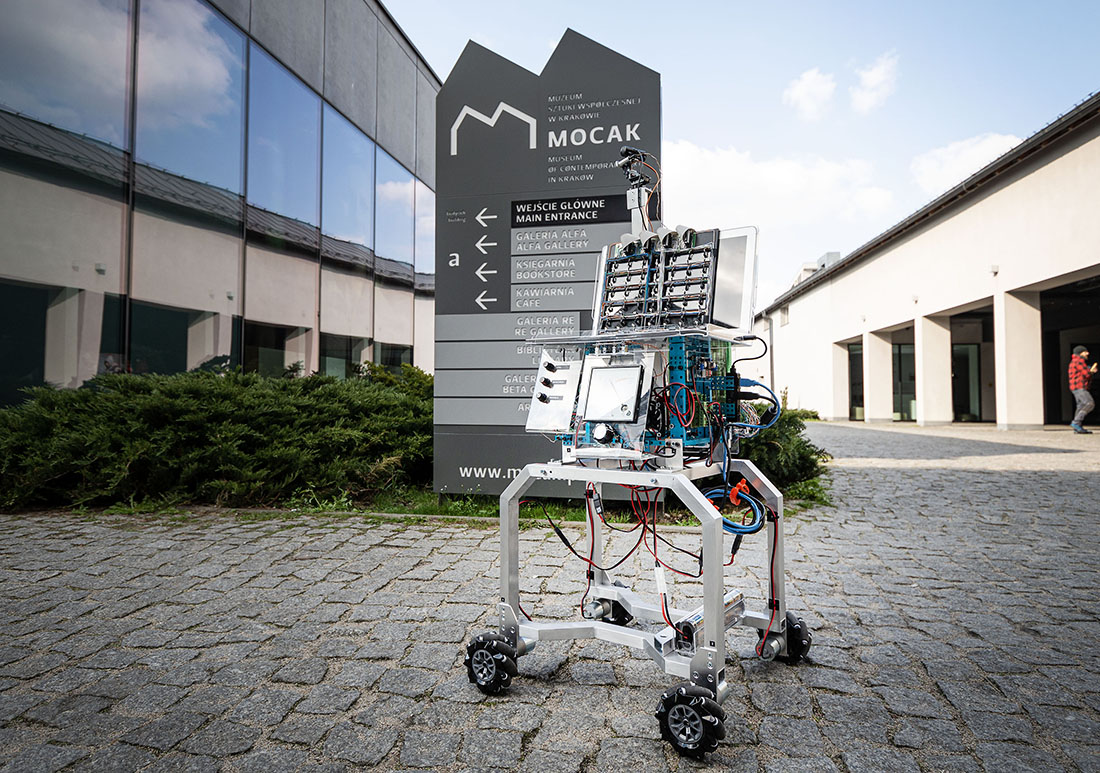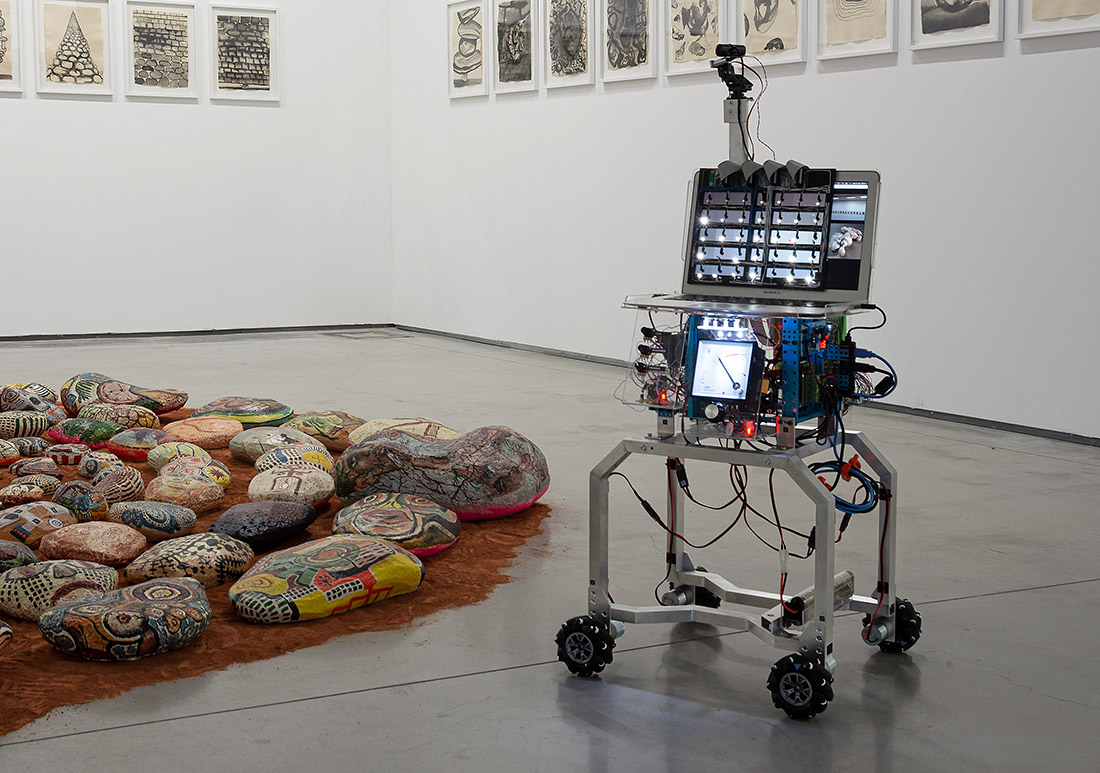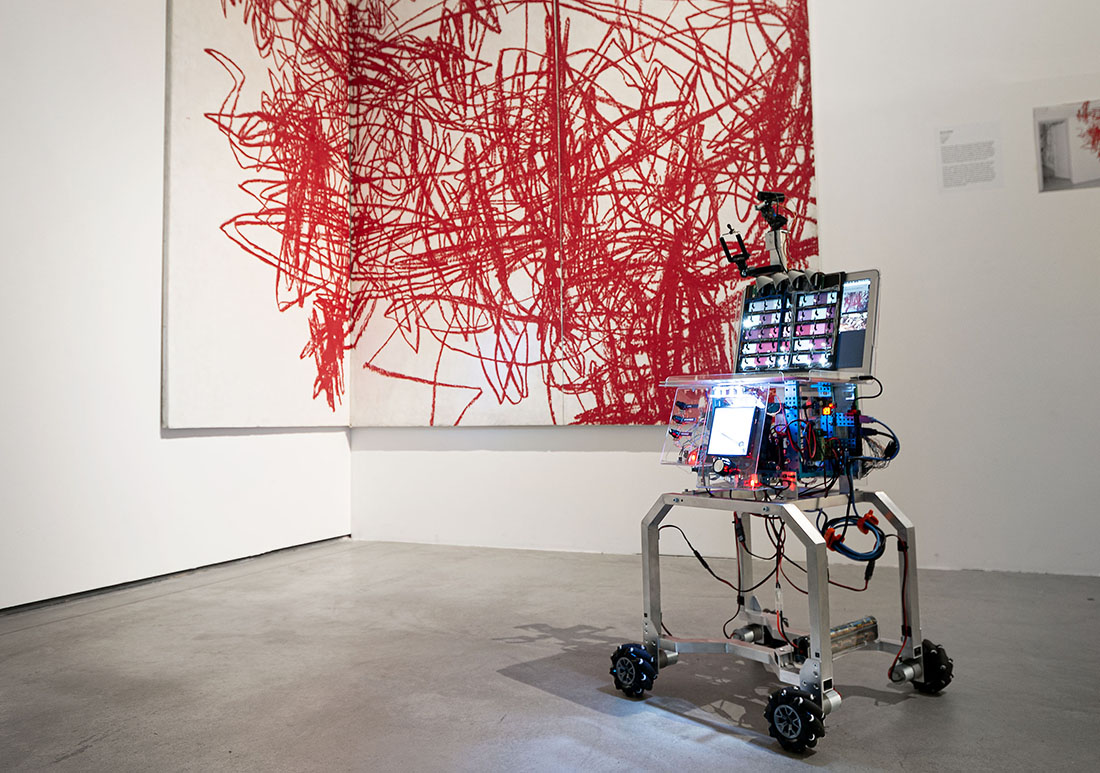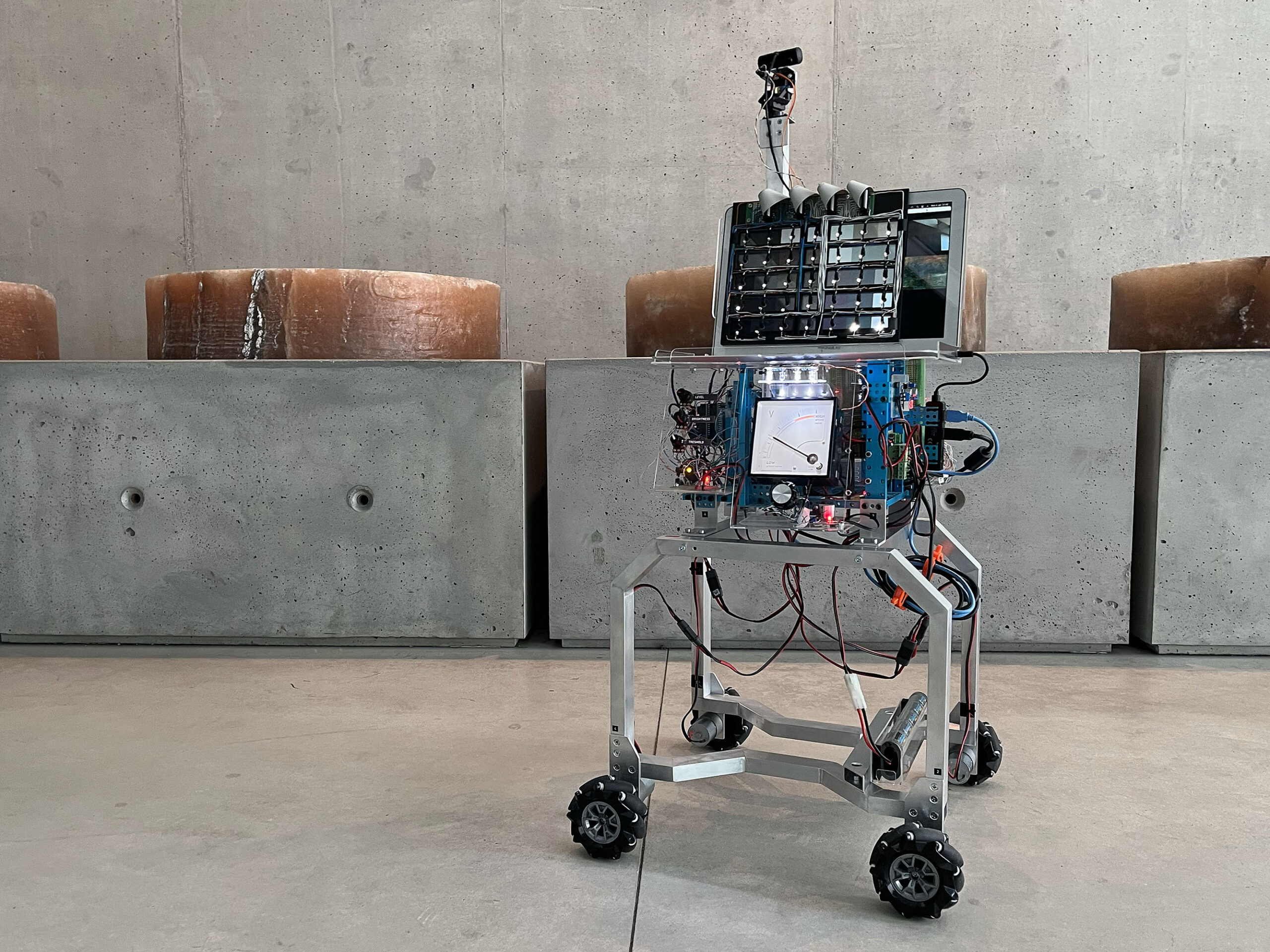remember(me), 2014
aluminium construction, engraved plexi panels, hydraulics, black liquid, electronic components
The installation that generates a story about the cultural and social relationship between human beings and machines; a retro-futuristic vision that intertwines the past with the future. Jasielski’s project is a large-scale object in which a hydraulic system pumps the black liquid. The liquid slowly, gradually fills the grooves hollowed out in transparent sheets of plexiglass, revealing futuristic dream-like images of factory workers. These drawings were inspired by archival materials from Warsaw’s Fabryka Samochodów Osobowych – FSO (Passenger Car Factory). Jasielski has recreated those illustrations in a way that makes it impossible to date the period from which they actually originate. They simultaneously depict the past and the future. The engravings filled with liquid generate unique patterns in successive cycles. The fully automatic, electronically controlled system creates a huge spatial object composed of tanks, pumps, pipes, valves, switches, wires, and sensors. It creates a futuristic vision of a near future or an alternative present, in which the main role is given to heroic human-machine hybrids, cyborgs, or robots. This vision is both contemplative and full of energy, transporting viewers into an alternative dream-like time-space.
The drawings, cut into layers of plexiglass, have a significance of their own – they were based on stills from a 1978 documentary on the production system at the Passenger Automobile Factory in Warsaw. The film, directed by Antoni Dzieduszycki, glorified the new world in which human labor would be minimized and replaced by robotization, and where the factory system would be automated. As an art historian and art filmmaker, Dzieduszycki presented his reportage from the factory in a form that was permeated with the experience of the avant-garde and cybernetics. In Jasielski’s artistic deconstruction of this documentary, the idea of factory automation also becomes one of many media-constructed narratives about the entanglement between the systems of power, technology, and the project of the future, with the management of the human body, labor, and time. In the comic book style of his drawings, Jasielski emphasizes the robotic dimension of human work – the workers are given modern tools and overalls – which somehow integrate them even more with the production line. These images are devoid of any sign of human effort and the importance of physical labor. When the various ways in which the human body is exploited are hidden, this allows thought to focus on increasing productivity. Human labor, as ‘living labor’, is displaced by a new product – automated ‘dead labor’. Thus arises modern capital, which must constantly be in motion in order to be transformed back into ‘living labor’ and retain its productivity.
Lucidography – the original technique invented by the artist, meaning imaging of a lucid dream or hallucination.
Justice Control Unit, 2024
aluminium construction, computer, monitor, camera, microcontroller, electronic components, custom AI system, 80/130/180 cm
Machine for monitoring the administration of justice
In the era of artificial systems, artificial justice seems a threshold of technological ethics. As we systemically put the judgement of our social conduct “in the hands” of AI, our human sense of right and wrong becomes more superficial. This superficiality, however, does not originate from the prevalence of intelligent machines and algorithmic decision-making, but from a long history of human reliance on the systems monitoring morality. The Justice Control Unit draws on that history, exploring how the use of advanced technologies exposes a paradox of externalizing moral judgment and figures of moral authority.
An interactive machine – embodying the authority and the judge in one – the Justice Control Unit uses AI algorithms to assess the likelihood of a user committing a crime and then independently administers justice. Its structure resembles the fake electric shock generator built by Milgram, and can be controlled with knobs that adjust for gender, skin color, economic status, ethnicity, sexual identity etc. Based on these parameters, facial recognition technology guides the Unit towards a final verdict on a user’s criminal propensity, subsequently shocking those it deems guilty with an electric impulse. The assessment parameters that decide the extent of the user’s "guilt" also decide the strength of the punitive electric impulse. In this way, the work directly references AI technologies used in the justice systems of the USA and China, which are currently still in the planning stages in Europe. An interaction with the Justice Control Unit allows for an experiential conceptualization of those technologies, especially the randomness of algorithmic decision-making whose policing effects we tend to ignore.
AI surveillance is notorious for its inherent bias embedded within many AI algorithms, often reflecting and amplifying existing societal prejudices, leading to discrimination or disproportionate targeting of “certain” communities and individuals. Facial recognition technology exhibits higher error rates for people of color, raising serious questions about its fairness and accuracy. Furthermore, predictive algorithms in law enforcement designed to forecast criminal activity based on historical data perpetuate the over-policing of certain social groups. A common failure to account for the socio-economic and systemic factors that contribute to prejudiced data interpretation results in punitive approach and criminal bias. This raises significant moral and legal questions about the role of AI in perpetuating existing inequalities but also about the failed efficiency of a moral judgement.
Text: Ania Malinowska
Small Apocalypse, 2023
meteorite, prepared MacBook, optical lenses, laboratory table, loudspeakers dimensions: 120/60/80 cm
The heavily destroyed, but surprisingly sill functional laptop plays looped movie about the meteorite fall. The movie was shot using a scanning electron microscope and shows micro scale images of the small chunk of the real iron meteorite. The very same meteorite is presented on the table. The viewers can observe it through the custom set of optical lenses.
Since the dawn of time, human gazing at the night sky has been accompanied by cognitive insufficiency. Before we realized the infinity and unfathomability of cosmic phenomena, we tried to create ordo ex chaos: the calculations of the ancient Egyptians allowed us to predict solar eclipses, Pythagoras listened to the harmonia mundi, and the Copernican revolution proved that the logic of the movement of celestial bodies can really affect the social and ideological order. However, the narcissistic nature of the space studying mind was occasionally disturbed by irregularities in the form of asteroids or meteorites. The nomadic trajectories of these objects fascinated with their anarchy and unpredictability. "Shooting stars" became the source of more phantasms and myths. However, did the development of (terrestrial) civilization and the advancement of knowledge in the first half of the 21st century significantly change our approach to these objects? Both contemporary science and Hollywood pop culture seem to still base their aspirations on the Kantian category of the sublime - a mixture of rationality and emotions, experiencing fascination and horror. This moves us into the area of aesthetics, reflection on the phenomena of sensual perception. The actual meteorite fragment used in this project was placed in a vacuum [from which it actually came] to be examined by SEM [scanning electron microscope]. The resulting images were used in a very unusual way to create a short film. The standard SEM research procedure has been dramatized here ad hoc, successive stages of enlargement, instead of cognitive satisfaction, paradoxically intensify anxiety, and knowledge becomes an irrational source of danger. The way the film is presented is also quite unusual. It is displayed on a completely destroyed but still working laptop. A large burned crater in the computer’s case suggests a catastrophe caused by a meteorite debris impact. The laboratory setting and mechanical repetition of the film further enhances the post-apocalyptic perception of the work.
Robotic Curator, 2022
laptop, electronic components, microcontrollers, DC motors, servos, batteries, digital camera, aluminium construction, dimensions: 50/40/130 cm
Robotic machine built to replace human curators.
Who is the contemporary curator? Researcher or creator, producer or rather negotiator? Is it possible to assign his powers to a machine?In theory, we can use practically limitless robotic computational power and memory to precisely program aesthetic choices. Or even more – we could use it to analyze and predict artistic trends. All that without subjectivity, politics, institutional entanglement, and celebrity.
Robotic Curator was created with one main purpose - to visit galleries and museums and evaluate exhibited artworks. It does that using a specially designed artificial sense of aesthetics. It is based on a unique perception matrix, custom built by the artist. The matrix simplifies images from the onboard camera and converts them to a pattern, which further is compared with the built-in artwork database. The evaluation process is the result of these associations combined with data from the matrix. The calculated artistic value is displayed on the big meter mounted on the robot's body. The robot also expresses his judgment by displaying text messages, speaking, and in extreme situations vibrating. The level of his judgmental attitude can be easily changed by turning the big knob.
Observing the Robotic Curator in action forces us to rethink our own mechanisms of processing images into internal discourse with all the complex contexts, subjective perspectives, and visual literacy. Its seemingly simple alien mind and awkward body carries a huge load of irony aimed both at artworld and technology.
Oracle, 2017
metal and plywood construction, electronic components, computer, Arduino, digital camera, LCD monitor, dimensions: 550/350/550 cm
Palm reading machine foretelling the future of the viewer.
In a perverse manner the installation brings an experience of a myth of oracle, which in an enigmatic way can predict our future. The work recalls subconscious cultural traditions such as chiromancy and ancient Greek oracle, whose foretell is difficult to verify. The whole installation is a programmed machine that randomly reveals its personality – sometimes its prophecies tease the viewer directly (presenting messages like “how about a date tonight” or “you have such beautiful eyes” from time to time). This is yet another author’s experiment with the emotionality of machines, or rather the emotionality roused in a human due to contact with a machine. The artwork also encourages reflection on trust in technology and our dependence on it, as well as the fear of its domination.
Paper Clock, 2017
paper, glue, dimensions 500/300/400 cm
Monumental, fully functional clock hand made entirely out of paper, without using any additional materials.
It’s construction based on a traditional clockwork movement was created experimentally with a huge amount of labour. Gravitationally powered, by paper weights it allows alternative time measuring. The project combines artists experiments both with paper as a fragile and obsolescent matter and searching for alternative solutions in engineering work with the machine. In this case clock, that is supposed to be a tool for precise measure of reality, is practically useless: it tells the time incorrectly and its dial is impossible to read. Furthermore, contrary to the tradition, it is not a lifelong clock because of the impermanence of paper, so the life expectancy is impossible to determine.
Its sense, conditioned by the denial, is an exemplification of the resistance towards the homogeneous development of technology and fitting men into rationality schemes.The ironic game of “resistance to the system” by knowingly committing an error fosters searching for new solutions.
Photo Robotoid, 2016
custom built robot, digital camera, laptop, printer, LCD monitor, custom steel body, dimensions 120/120/200 cm
A photographic robot with a built in choice making capability taking portraits of the audience.
Controlled by a custom software robotic arm, it operates a DSLR camera with mechanical shutter release. All photos taken are immediately printed and dropped on the ground. Kinnect operated body and movement identification allows the user to precisely point the camera and take a perfectly composed portrait. However, because of it’s settings, the Robotoid seldom takes photos we normally consider to be usual. Carefully chosen parameters of the program steering the robot change constantly, making it’s actions different from a normal machine behaviour. However, unlike the human photographer it suddenly switches its attention from one object to another, releases the shutter at unexpected moments and concentrates on “less important“ actions and details.
What also makes taken photos very unusual is people's behaviour in front of a camera which is not operated by a person. They are much more natural and less posed. They are naturally driven into a specific game when they act and move in front of the robot, trying to influence its actions when taking their photo.
Self Enlargement, 2019
used cardboard cutting boards, robot with microscope, steering panel, laptop, LCD screen, dimensions: 200/150/200 cm
The installation allows viewers to navigate the robot with the microscope on the surface of the cardboard cutting mats, which in the past were used to execute artistic works.
By changing the scale to micro, looking at the notes and traces of activity becomes an exploration of a landscape reminiscent of another, alien reality.
The artist not only gives a glance at his creative process, which resists the Western tradition of displaying the final form of a work of art. Though, his experiment-based art is largely due to inspiration with scientific methods based on tests, errors, analyzes and multiple thought processes. For Jasielski, however, playing with optics ironically brings the aspect of contemplating the power of artistic gesture.
Emotions Control Unit, 2015
wooden cabinet, electronic components, Arduino micro controller, voltmeters, dimensions: 80/70/170 cm
This installation is trying to negotiate nostalgia of the simple machine designed to resemble early radio receivers with typically human emotions. Based on the custom built wooden enclosure, equipped with distance and touch sensors, and the microphone it uses especially created program reacting to behaviour of the viewers in the gallery, and “showing its emotions” on set of meters.Viewers can switch on and off sets of sensors responsible for three dimensional seeing, touch and hearing and change the machine's behaviour and fine tune the particular “emotions”. In addition machine's 'emotions' make them react emotionally. Viewiers anthropomorphizethe machine by acknowledging its human feelings. This model holds that words such as ”anger”, ”sadness”, ”fear” etc. describe unique mechanism, which is triggered by discrete mental states, leading to unique, measurable outcomes. In this view exist a limited number of biologically determined basic emotional processes, which considering specific form, function an a cause, are different from mental processes like cognition or perception.
The project is the latest continuation of the Control Units series of works.
Analog immigration, 2013
Copper mesh, steel, oscilloscope, steel cabinets, signage, immigration forms, stamp, immigration personnel, dimensions: variable
Analog Immigration is a specific back-in-time travel to the period when there were no digital devices. Viewers can experience the analog era – a place devoid of constant internet access and cell phones. The copper mesh and steel structure, like a Faraday cage, block and filter electromagnetic signals including wi-fi and mobile networks. Additionally, every person entering the show is being asked to leave all digital devices at a checkpoint at the entrance.
This work supports the viewer with a kind of a respite from modern technologies, surrounding nowadays all their senses. It can become a shelter, but also a space of deprivation, where we loose orientation due to decline of stimulus, that very often regulate our everyday experience.
Paper Bridge Over Stone River, 2012
paper, dimensions: 550/130/60 cm
Fully functional bridge made entirely out of paper. The design was created basing on the traditional Japanese bridges built at the entrance to the temple grounds. It is a kind of a test for architectural, physical capacity of material, which is dealing rather with symbolical communication than the material one. In the same time it is worth seeing the function of connecting people and objects. While presentation viewers were invited to have a walk and test the strength of the construction.
Object was created during artistic residency at Tokyo Wonder Site in 2012.
Lewiatan, 2013
MDF board, subwoofers, audio equipment, self made electronic circuits, movement sensors, dimensions: 780/210/90 cm
The Leviathan project combines the artist’s search in the realm of technology and sound with his fascination with the utopian visions of the world dominated by machines. It is an attempt to create an artificial electronic organism showing the features of a living creature. The object is covered with a sensors reacting to motion and emits various sounds and vibrations as a result of interaction with the audience. Leviathan contradicts the privileged position of a human being as regards technology and the utilitarian use of the machine. It grants the machine its own subjective identity. This unique object takes up a game with the economics of desire too. Unlike devices and gadgets purchased on a mass scale, which are to improve our lives or provide entertainment, Leviathan remains non-assimilated and in its own way – passive. It is an “alien/other”, a thing coming from a different order of reality, unpredictable and self-controllable.
Installation causes air oscillation, changing the way the space is sensed by viewers. Both, the title and the form of installation refer to bible monsters, forecasting the catastrophe.
Global Warming Control Unit, 2010
humidifiers, aluminium, rigid PVC boards, water tank, electric fixtures, dimensions: 300/350/500 cm
Interactive machine producing fine fog in an intention to reduce global warming effect. Clouds are increasing sun rays reflectivity lowering the temperature. This experiment emphasizes the meaning of art for transforming of both everyday life and global experiences.It is also an ironic comment on the role of the Science in the world dominated by the logic of technology, in which functionality and rationalization have are of commercial nature. Project was based on the idea of American and British scientists.
Earthquake Control Unit, 2004
steel profiles, masonite, loudspeakers, table, dinnerware, audio equipment, dimensions: 100/350/70 cm
An interactive device generating low earthquakes, controlled by a knob manipulating the force of shakes.
Earthquake Control Unit allows anyone to produce, experience and even play with an earthquake. This object reproduces very low frequency sound waves recorded during an actual quake in California.
The work was created during an artistic residency at the Montalvo Arts Center. It is located on the outskirts of the Silicon Valley, in one of the most seismically active regions of the world. Since quakes of varying strenght are almost everyday there, this element is a real threat that evokes very emotional reactions.
Earth Rotation Speed Control Unit, 2003
steel, plywood, car winch, battery, digital prints, dimensions: 320/250/250 cm
The machine is able to slow down the Earth's rotation, making the day longer by a very small fraction of a second. The important part of a project is a physical theory explaining influence the object has on the planet and referring to every kind of human activity, including art. The tool designed by the artist can be also understood as an attempt to influence global course of events and simultaneously is a kind of the gesture of auto denunciation – revealing that art means experimenting in the name of measurement, verification and interpretation of cultural, geographical and physical phenomena.
Technical Drawings, 2017
paper, glue, graphite grease, dimensions: 20/500/150 cm
Paper chain seized with graphite grease
The object belongs to a series of works madein situ, which form is inspired by machine elements. This is a pawky kind of technical drawing, rising to a three-dimensional form, using graphite grease on paper. A technological element is used in an absurd way, denying its original function: grease, as opposed to its typical appliance, acts as a binder in this case. Technical Drawings demonstrate a remark of the relationship of art and engineering, in the form of an object taken from the field of technology subjected to artistic analysis.
Drawings and sketches, 2019
paper, pencil, ink, watercolor, various dimensions
An inseparable part of creating art by Jasielski is the visualization of the idea with drawing. Traditional technique is not, however, the closing of the process of imagining the final version of the work, but an additional level of variation on the subject of technological design.The stage of preliminary preparation of creative work, therefore, broadens the real technical and engineering possibilities for the artist. Sometimes it also becomes an absurd, impossible to implement, vision.
Contact
mail: przemoj@zero2.plBio - download Bio

Born 18.02.1970 in Poznań
Education:
Sculpture at Academy Of Fine Arts in Poznań 1989-1994
Master degree/diploma 1994 sculpture in prof. Jan Berdyszak studio and drawing in prof. Jarosław Kozłowski studio
Residencies:
2003 – The Gallery, International Artist in Residency Center, Guernsey, Great Britain
2004 – Lucas Artists Residency in Montalvo, California, USA
2010 – Gyeonggi Creation Center, South Korea
2012 – Tokyo Wonder Site, Tokyo, Japan
2013 – Creative Fusion Residency, Sculpture Center, Cleveland Ohio, USA
Conferences:
2014 – Post-technological experiences. Art-Science-Culture, Poznan, Poland
2016 – Technarte, Bilbao, Spain
2018 – Artobots, CODAME, San Francisco, USA
2018 – Technarte, Los Angeles, USA
2019 – Art&Science: The Future is Here, Le Guern Gallery, Warsaw
2019 – Artist Talk. Living with Machines (AI), ISEA, Gwangju, South Korea
2019 – Artist Talk: Sztuczne natury jako archiwa Antropocenu. Akademia Miasta, Malta Foundation, Poznań
2022 – Artist Talk: Hypnotic AI, ISEA, Barcelona, Spain
2023 – Alien SLASA, Arizona State University, Phoenix, USA (exhibition and workshop)
Workshops:
2018 – MOCAK, Kraków, Poland
2019 – Armenia Art Fair, Yerevan, Armenia
2019 – Rigid Paper Construction (workshops + exhibition), SIAF, Sapporo, Japan
2019 – Sztuczne natury jako archiwa Antropocenu. Akademia Miasta, Malta Foundation, Poznań
Selected solo exhibitions:
1994 – To hear the sound of an angel wings and to measure it (Academy of Fine Arts, Poznań)
1997 – Sounds of my room – installation (Potocka Gallery, Cracow)
1998 – To see the sound of an angel wings (Laboratory Gallery, Warsaw)
1999 – To see the sound of an angel wings – Hollywood version (Potocka Gallery, Cracow)
2003 – Earth Rotation Speed Control Unit (OPTICA Centre for Contemporary Art, Montreal, Canada)
2003 – To see the sound of an angel wings – anatomical version (The Gallery, International Artist in Residency Centre, Guernsey, Great Britain)
2004 – Earthquake Control Unit (Lucas Artists Residency in Montalvo, California, USA)
2006 – Hi-Fi (Oko/Ucho Gallery, Poznań)
2006 – White Noise (AT Gallery, Poznań)
2008 – Ukukula (Munandi Art Center, Lusaka, Zambia)
2009 – Drawings Of Something Completely Else (Le Guern Gallery, Warsaw)
2010 – Global Warming Control Unit (Gyeonggi Creation Center, Seongamdo, South Korea)
2011 – Opportunity (Skolska28 Gallery, Prague, Czech Republic)
2012 – Paper Bridge Over Stone Water (Tokyo Wonder Site, Tokyo, Japan)
2013 – Analog Immigration (CSU Galleries Cleveland Ohio, USA)
2014 – Leviathan (Le Guern Gallery, Warsaw)
2019 – Photo Robotoid (Le Guern Gallery, Warsaw)
2020 – Oracle (AT Gallery, Poznań)
2023 – Non-Human Portraits (PF Gallery, Poznań)
2024 – Justice Control Unit (Le Guern Gallery, Warsaw)
Selected group shows:
1992 – Project Istropolitana (Bratislava, Slovakya)
1993 – Ideas without ideology (CSW Ujazdowski Castle, Warsaw)
1996 – Generation 96 (BWA Gallery, Katowice)
1998 – Partie 6 (Drewen, Germany)
2000 – New Media Art from Poland (Oldenburg, Germany)
2004 – Nature of/and art (Bunkier Sztuki, Cracow)
2007 – At last, Something new! Collections of Modern art from Malopolska (National Museum, Cracow)
2008 – 8784h Project (X-RAY Gallery, Luboń)
2011 – Not In Place (CSW Ujazdowski Castle, Warsaw)
2012 – Drawings Of Something Completely Else (BWA Zielona Góra)
2013 – Black Suns (Wschodnia Gallery, Łódź)
2013 – Transnature Is Here (Malta Festival, Poznań)
2013 – homeMade (CSW Łaźnia, Gdańsk)
2014 – Post-Technological Experiences. Art-Science-Technology (Zamek Culture Centre, Poznań)
2014 – Machined Senses (The Sculpture Center, Cleveland Ohio, USA)
2015 – Nonsense Technologies, Przemysław Jasielski & Rainer Prohaska (MONA Inner Spaces, Poznań)
2016 – Apparat. Retrogression Through Technological Progress, Przemysław Jasielski & Rainer Prohaska (The Sculpture Center Cleveland Ohio, USA)
2016 –„L’arte differente: MOCAK al MAXXI” MAXXI – (Roma, Italy)
2017 – Not To Be Seen, Przemysław Jasielski & Rainer Prohaska (WRO Art Center, Wroclaw)
2017 – Draft Systems (WRO 2017 Biennale, Wroclaw)
2017 – Nonsense Technologies (MOCAK Museum of Contemporary Art in Krakow, Kraków)
2018 – do it (Superkurator, WI-MA, Łódź)
2019 – Lux Aeterna. Special Exhibition (ISEA, Gwangju, Korea)
2019 – Posthuman_Data (HAT Research Center/PCSS, Poznań)
2020 – Anthropocenes. Reworking the Wound (SLSA, online conference)
2020 – Of Roots and Clouds – online presentation (SIAF, Sapporo, Japan – exhibition cancelled)
2021 – The Artist Is Present (MOCAK, Kraków)
2023 – Not This Sky (ZAMEK Culture Centre, Poznań)
2024 – Gwangju Biennale, Polish Pavilion (Gwangju, South Korea)
